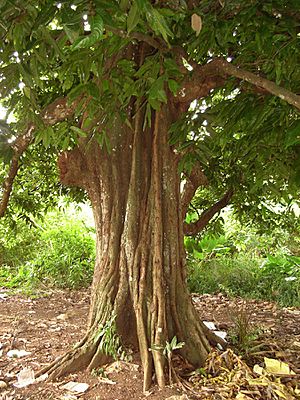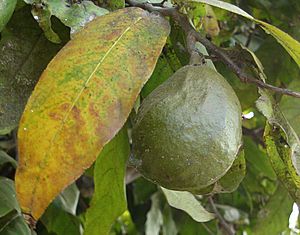Tahitian chestnut facts for kids
Quick facts for kids Tahitian chestnut |
|
|---|---|
 |
|
| Conservation status | |
| Scientific classification | |
| Kingdom: | |
| (unranked): | |
| (unranked): | |
| (unranked): | |
| Order: | |
| Family: | |
| Tribe: |
Dalbergieae
|
| Genus: |
Inocarpus
|
| Species: |
I. fagifer
|
| Binomial name | |
| Inocarpus fagifer (Parkinson ex Zollinger) Fosberg, 1941
|
|
| Synonyms | |
|
|
The Tahitian chestnut, also called the Polynesian chestnut or mape tree, is a special type of flowering plant. Its scientific name is Inocarpus fagifer. This tree belongs to the legume family, which also includes peas and beans.
You can find the Tahitian chestnut growing across the warm, tropical areas of the south-west Pacific and south-east Asia. People in Polynesia and Melanesia have used this tree for a very long time. It's the only tree in its group, Inocarpus, that is important for food and culture.
Contents
About the Tahitian Chestnut Tree
The Tahitian chestnut tree comes in many different sizes, shapes, and colors. Its leaves, flowers, and fruits can also look quite different. This is because people have grown and chosen the best trees for a long time. Over many years, different types (called cultivars) have likely developed, even if they haven't been officially named.
Size and Lifespan
The Tahitian chestnut is a medium-sized tree that stays green all year. It can grow up to 20 meters (about 65 feet) tall, but some can reach 30 meters (nearly 100 feet)! Its top part, called the crown, can spread 4 to 6 meters wide.
The bottom of the tree trunk often has strong, wide supports called buttresses. The bark is rough and brown, becoming grayer as the tree gets older. This tree can live for a long time, usually 80 to 90 years.
Leaves
The leaves of the Tahitian chestnut are dark green and look like long oval shapes. They are tough and leathery. Each leaf is about 16 to 39 centimeters (6 to 15 inches) long and 7 to 13 centimeters (3 to 5 inches) wide. The tip of the leaf is pointed, and the base is rounded. The veins on the leaves are yellow and run opposite each other.
Flowers
The flowers of the Tahitian chestnut are very fragrant. They grow in small groups at the ends of branches. Each flower is about 10 millimeters (less than half an inch) long. They have five petals that are white, cream, or light yellow.
Trees start to produce flowers when they are 3 to 5 years old. They usually bloom in November and December. The fruits then appear in January and February. However, this timing can change depending on where the tree grows and the year.
Fruit and Seeds
The tree begins to grow fruit when it is about eight years old. The fruits are a bit flat and can be round or oval. They weigh between 50 and 110 grams (about 2 to 4 ounces). The fruit's skin is smooth, and inside there's a tough, stringy shell that holds the seed.
When the fruits are young, they are green. As they get ripe, they turn yellow or orange-brown. The seed inside is white and shaped like a kidney. It's quite large, weighing 5 to 50 grams. The seed is poisonous if eaten raw, but it becomes safe and tasty when cooked.
The soft, fleshy part of the fruit is eaten by birds like cockatoos and flying foxes. When they eat the fruit, they help spread the seeds to new places.
Where Tahitian Chestnuts Grow
The Tahitian chestnut thrives in warm, wet tropical areas. It needs a lot of rain, usually between 1500 and 4300 millimeters (about 59 to 170 inches) each year. It can grow from sea level up to 500 meters (about 1640 feet) high.
This tree can grow in many different kinds of soil. It can handle soils that are very chalky or salty. It can also grow in wet, swampy areas or in soils that are not very rich in nutrients.
In the past, people grew this tree more often. Now, it's mostly found growing wild. Its natural home stretches from Malaysia in the west, across Melanesia, north-eastern Australia, and Micronesia, all the way to the Marquesas in Polynesia in the east. You can often find it in forests that are growing back, along riverbanks, in swamps, near the coast, and even in mangrove areas.
How People Use the Tree
The Tahitian chestnut tree has many traditional uses. Almost every part of the plant is helpful!
Traditional Uses
- Medicine: The leaves and bark have been used in traditional herbal medicine.
- Thatching: In Fiji, the leaves are used to make roofs for traditional houses called bure.
- Fuel: Fallen branches are used as firewood. Green wood is burned to help dry copra (dried coconut meat).
- Building and Crafts: The wood is used to make carvings and tool handles. It's also used for building canoes and for light construction.
Food Uses
While humans can't eat the fleshy part of the fruit, the seeds inside are a very important food source in many Pacific island countries. These seeds are rich in protein (about 5%) and carbohydrates (about 22%). Remember, they must be cooked to be safe to eat!
People cook the seeds in many ways, including roasting, grilling, boiling, and baking. In places like Papua New Guinea, the Solomon Islands, Vanuatu, Fiji, and Polynesia, the cooked seeds are often mashed into a soft dish, like a pudding.
Other Uses
The tree is also useful in agroforestry. This means it helps with farming and the environment. It can help protect coastlines and stabilize soil. It can also provide shade for other crops that need it, like cocoa. The tree also acts as a windbreak, protecting other plants from strong winds.
A mature tree, over 25 years old, can produce a lot of fruit. It can yield up to 75 kilograms (about 165 pounds) of fruit each year!
Fun Stories and Myths
People in different places have interesting stories and myths about the Tahitian chestnut tree:
- In Samoa, some people believed that humans originally came from the Tahitian chestnut tree.
- On Choiseul Island in the Solomons, there's a story about a man who upset a tribal chief. The people around him had eaten a lot of cooked Tahitian chestnut seeds. The story says the man was overcome by the strong smells that resulted from everyone eating the seeds!
Images for kids
See also
 In Spanish: Castaño de Tahití para niños
In Spanish: Castaño de Tahití para niños




